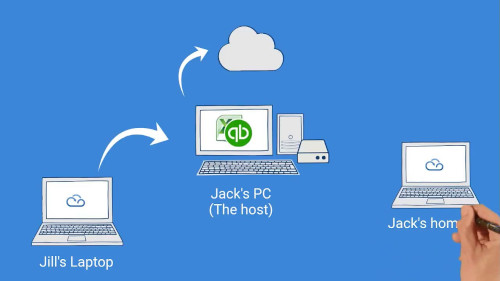A growing number of people work remotely. Supervising remote employees presents unique challenges because they aren’t physically present at work, making managing them different from overseeing regular employees. The benefits of well-managed remote employees are numerous, however. How to manage remote employees more effectively and what virtual work is.
Remote work: what is it?
Remote work refers to any work performed outside the traditional workplace. Working from home is also known as teleworking, telecommuting, or telecommuting. You or your employees can complete work from home instead of commuting to the office. It also means that employees can be anywhere in the world, not just within a commutable distance of your business.
Remote work is usually done digitally, with employees using computers to complete the tasks they would normally perform in the office. Using remote access software, connecting to an online work portal, or taking files home are all options.
Employees who work remotely have what advantages?
Remote employees have many benefits for your business. Take a look at these:
Boosted productivity
The productivity of remote employees has been widely reported. As a result, they have more flexibility during the workday and can devote more time to their work without distractions. Besides saving time on their commute, they also save money.
Increased employee happiness
Working from home often results in happier and more satisfied employees. Employees who are happier tend to be more productive and more likely to stay with the company. The result is an increase in business productivity and employee retention, which, in turn, reduces costs.
Cost savings for the business
The cost of office space can be reduced by having remote employees. The cost of cleaning, maintenance, and utilities is included in this category. Having a remote workforce allows you to reduce the size of your office or even run your business entirely from home.
More talent to choose from
You can access a global talent pool by employing remote employees. You are no longer limited to hiring people within commuting distance of your business. You can hire people anywhere in the world instead.
How to manage remote employees effectively
Here are 11 tips for managing your business’ remote employees:
1. Establish effective communication methods
Communication is one of the biggest challenges of managing remote employees. If you need something, you can easily communicate in person in a regular office. Having multiple communication tools is essential for remote communication. When using telecommunications tools, make sure you have a way to speak directly with people (e.g., over the phone), a video conferencing tool, and messaging software. New business communication tools integrate messaging, voice, and video chat with scheduling and file sharing capabilities.
2. Expectations should be clearly defined
Employees should be expected to show up on time to work and to use appropriate language in the workplace when managed in person. Remote communication doesn’t follow these guidelines as clearly. You should set clear expectations for remote workers’ working hours so that they can get the most out of them. It may entail answering messages during working hours, using professional language in messages, minimizing background noise during conference calls, etc.
3. Meetings should be scheduled regularly
Since you can’t casually check in with a remote employee, you need to schedule regular meetings to keep track of their progress. As a result, you’ll be able to see how they’re doing at work and measure their progress on a regular basis. Your employees can also ask you any questions or discuss any concerns they may have. The regular meetings you have may be short daily chats, longer weekly meetings, or lengthy monthly meetings, depending on your needs.
4. Create a sense of community among your employees
To ensure your remote employees feel connected to your company, it’s important to foster a sense of community with them and foster a sense of friendliness with them. Group chat channels and asking people how they feel during meetings can help you accomplish this. To help remote employees overcome challenges, you should also encourage open communication between them.
5. Open your doors to everyone
Working with remote employees can be challenging, especially when time zones differ. You may not be able to reach them outside of scheduled meetings, so they may not communicate their issues immediately. Establishing an open-door policy with your employees will let them know that you are available for unscheduled discussions. In addition, you should respond promptly to messages and use software tools, such as out-of-office messages, to communicate your availability.
6. Manage without micromanaging
Among the most important aspects of remote work is the autonomy it provides. They can approach their work in a way that suits them when they work remotely. You may assume that your employees aren’t actively working when you’re not in the same office as them. You may affect your employees’ productivity, however, if you monitor their progress constantly.
Regularly check your remote employees’ progress instead. To ensure remote employees can keep working without feeling too closely monitored, make sure your work tracking tools are unobtrusive and easy to use.
7. Your remote employees need the right equipment
Providing your remote employees with all the tools they need is crucial. Home office arrangements and the software they use both play a role in this. You can help your remote employees stay productive, stay engaged, and maintain a high level of quality by providing them with home office equipment. Consider providing remote employees with a budget for home office equipment.
Furthermore, your remote employees need the right software and tools to do their jobs effectively. Especially if you expect remote workers to use their own hardware, you should ensure you use the right type of software license.
8. Your employees deserve your trust
Being unable to see what your employees are doing can make it difficult to trust that they are utilizing their time effectively. It is important, however, to trust your remote employees more. It shows employees that you believe in their abilities, and they’ll appreciate your support and trust. As well, you will be able to tell if a remote employee isn’t working properly by using appropriate performance metrics.
9. Allow yourself to be open to new ideas
Compared to traditional office arrangements, remote working is completely different. You may not have heard about new or better ways to work remotely. Consider using new tools, schedules, and software that can assist your team with remote working. Consider your remote employees’ suggestions carefully. Perhaps there is a better way to do things that you haven’t considered.
10. Ensure that everyone is included
Make an active effort to include remote employees in your company culture if you have both traditional office-based and remote employees. Communicate your values to remote employees just as you would to traditional employees. By making them feel included, you can improve their integration into your organization.
11. Time zones shouldn’t be ignored
Meetings and other work events can be easily arranged in a traditional office arrangement. It is possible, however, for remote employees to work from anywhere in the world. You should consider the time zone of your remote employees when scheduling meetings so that you don’t schedule one at 2 a.m. on the other side of the planet. Despite the inconvenience caused by time zones, it’s still best to be considerate of others.





